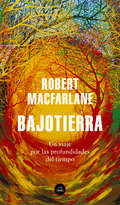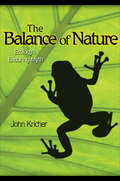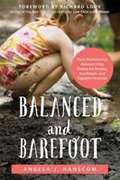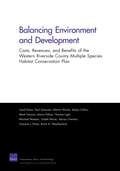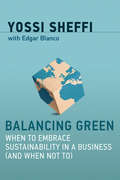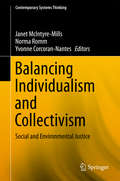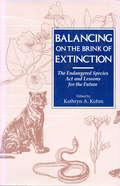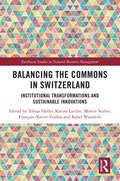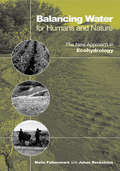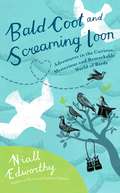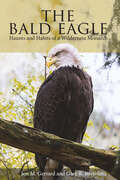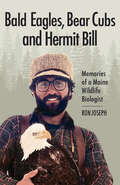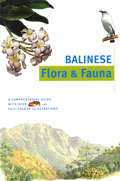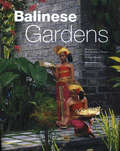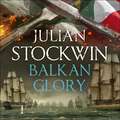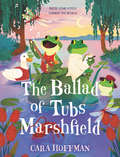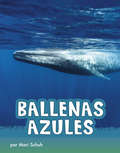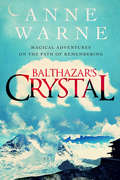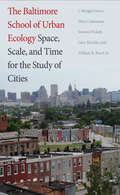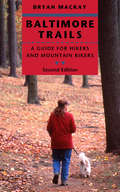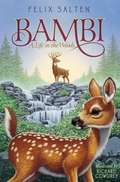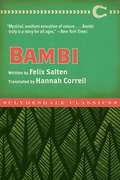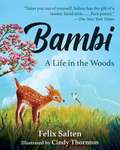- Table View
- List View
Bajotierra: Un viaje por las profundidades del tiempo
by Robert MacfarlaneRobert Macfarlane nos invita a bajar la mirada hacia las profundidades de la tierra: un descenso hacia la historia, la cultura y las memorias del subsuelo. «El gran escritor y poeta de la naturaleza de esta generación.»The Wall Street Journal ¿Por qué descender? ¿Qué sabemos de los mundos que yacen bajo nuestros pies? ¿Qué nos pueden enseñar de nosotros mismos? Bajotierra es una exploración épica del mundo subterráneo a través de los viajes del autor a variopintos paisajes del subsuelo y de la mitología, la literatura y la memoria que los acompañan. En este extraordinario periplo por nuestra relación con la oscuridad, el enterramiento, el pasado y el futuro de nuestro planeta, nos trasladamos de los orígenes del universo a una Tierra poshumana, pasando por las cámaras funerarias de la Edad de Bronce, las catacumbas de París, la macroinfraestructura para almacenar desechos nucleares en las profundidades de Finlandia, el deshielo de los glaciares de Groenlandia, los ríos que desaparecen bajo tierra, las cuevas bajo el hielo ártico y la red fúngica por la que se comunican los árboles. En su habitual afán por encontrar los vínculos entre el paisaje y el corazón humano y gracias a una prosa lírica y llena de fuerza, el autor expone e ilumina esta parte oculta y, apelando a nuestro tiempo, nos invita a ver el mundo desde una nueva perspectiva que indaga sobre el origen y la pérdida pero también en la esperanza y el miedo por el futuro de nuestra existencia. La crítica ha dicho...«Un libro excelente: valiente y sutil, empático y extraño.»Dwight Garner, The New York Times «Macfarlane se atreve a adentrarse en el mundo oculto de la tierra e iluminar no solo aquello de lo que huimos, sino también lo que no sabemos ni que existe [...]. Bajotierra es un portal de luz entiempos oscuros. Necesitaba este libro de belleza subterránea para equilibrar el dolor del que estamos siendo testigos aquí arriba.»Terry Tempest Williams, The New York Times Book Review «Una magistral y cautivadora exploración del mundo bajo nuestros pies [...]. Es como si, en lo profundo de la roca ancestral, Macfarlane estuviera ganando perspectiva no solo sobre el tiempo y sobre la naturaleza, sino también sobre su propia carrera literaria [...]. Un libro extraordinario, culto y ameno a la vez, emocionante y bellamente escrito.»Alex Preston, The Guardian «Construido a escala épica y escrito con un lenguaje bellamente elocuente y sensible [...]. Una narración de aventuras, terror, descubrimiento y esperanza [...]. Un libro lleno de sabiduría profunda y conmovedora humanidad.»Sean Hewitt, The Irish Times «Maravilloso [...]. Con una curiosidad inacabable, generosidad de espíritu, erudición, valentía y claridad [...]. Un libro que vale la pena leer.»The Times «Leer a Macfarlane nos conecta con nuevos y deslumbrantes mundos. Se trata de una conexión que nos brinda, más que nada, placer. Y ese placer, a su vez, nos conecta con aquellos artistas que pintaron, hace miles de años, rojas figuras danzantes en las cuevas de Noruega.»Barbara J. King, NPR «Extraordinario [...]. Al mismo tiempo docto y ameno, apasionante y bellamente escrito.»The Observer «Sorprendente y memorable, Macfarlane se ha convertido en Orfeo, el poeta que se aventura a las profundidades más oscuras y retorna -terriblemente solo- para cantar lo que ha visto.»New Statesman
The Balance of Nature: Ecology's Enduring Myth
by John C. KricherThe idea of a balance of nature has been a dominant part of Western philosophy since before Aristotle, and it persists in the public imagination and even among some ecologists today. In this lively and thought-provoking book, John Kricher demonstrates that nature in fact is not in balance, nor has it ever been at any stage in Earth's history. He explains how and why this notion of a natural world in balance has endured for so long, and he shows why, in these times of extraordinary human influence on the planet's ecosystems, it is critical that we accept and understand that evolution is a fact of life, and that ecology is far more dynamic than we ever imagined. The Balance of Nature traces the fascinating history of the science of ecology and evolutionary biology, from the discipline's early innovators to the advent of Darwin and evolution, to the brilliant and inquisitive scientific minds of today. Blending insights and entertaining stories from his own remarkable life in science, Kricher reveals how evolution is a powerful engine that drives ecological change, how nature is constantly in flux and, in effect, quite naturally out of balance--and how notions to the contrary are misguided and ultimately hazardous to us all. The Balance of Nature forcefully argues that an understanding of the dynamic nature of ecology and evolution is essential to formulating policies of environmental ethics to guide humanity toward a more responsible stewardship of our planet's ecosystems.
The Balance of Nature and Human Impact
by Klaus RohdeIt is clear that nature is undergoing rapid changes as a result of human activities such as industry, agriculture, travel, fisheries and urbanisation. What effects do these activities have? Are they disturbing equilibria in ecological populations and communities, thus upsetting the balance of nature, or are they enhancing naturally occurring disequilibria, perhaps with even worse consequences? It is often argued that large-scale fluctuations in climate and sea-levels have occurred over and over again in the geological past, long before human activities could possibly have had any impact, and that human effects are very small compared to those that occur naturally. Should we conclude that human activity cannot significantly affect the environment, or are these naturally occurring fluctuations actually being dangerously enhanced by humans? This book examines these questions, first by providing evidence for equilibrium and non-equilibrium conditions in relatively undisturbed ecosystems, and second by examining human-induced effects.
Balanced And Barefoot: How Unrestricted Outdoor Play Makes For Strong, Confident, And Capable Children
by Angela Hanscom Richard LouvIn this important book, a pediatric occupational therapist and founder of TimberNook shows how outdoor play and unstructured freedom of movement are vital for children’s cognitive development and growth, and offers tons of fun, engaging ways to help ensure that kids grow into healthy, balanced, and resilient adults. <p><p> Today’s kids have adopted sedentary lifestyles filled with television, video games, and computer screens. But more and more, studies show that children need “rough and tumble” outdoor play in order to develop their sensory, motor, and executive functions. Disturbingly, a lack of movement has been shown to lead to a number of health and cognitive difficulties, such as attention deficit/hyperactivity disorder (ADHD), emotion regulation and sensory processing issues, and aggressiveness at school recess break. So, how can you ensure your child is fully engaging their body, mind, and all of their senses? <p> Using the same philosophy that lies at the heart of her popular TimberNook program—that nature is the ultimate sensory experience, and that psychological and physical health improves for children when they spend time outside on a regular basis—author Angela Hanscom offers several strategies to help your child thrive, even if you live in an urban environment. <p> Today it is rare to find children rolling down hills, climbing trees, or spinning in circles just for fun. We’ve taken away merry-go-rounds, shortened the length of swings, and done away with teeter-totters to keep children safe. Children have fewer opportunities for unstructured outdoor play than ever before, and recess times at school are shrinking due to demanding educational environments. <p> With this book, you’ll discover little things you can do anytime, anywhere to help your kids achieve the movement they need to be happy and healthy in mind, body, and spirit.
Balancing Environment and Development: Costs, Revenues, and Benefits of the Western Riverside County Multiple Species Habitat Conservation Plan
by Lloyd Dixon Arthur Melmed Myles T. Collins Mark Hanson Martin Wachs Paul SorensenThe Western Riverside County Multiple Species Habitat Conservation Plan mitigates development effects on 146 plant and animal species by establishing a 500,000-acre conservation reserve. This monograph examines land-acquisition strategies and costs, revenue adequacy and potential new funding sources, the plan's habitat-conservation goals, and whether the plan has streamlined transportation and development permitting processes.
Balancing Green: When to Embrace Sustainability in a Business (and When Not To) (The\mit Press Ser.)
by Yossi SheffiAn expert on business strategy offers a pragmatic take on how businesses of all sizes balance the competing demands of profitability and employment with sustainability.The demands and stresses on companies only grow as executives face a multitude of competing business goals. Their stakeholders are interested in corporate profits, jobs, business growth, and environmental sustainability. In this book, business strategy expert Yossi Sheffi offers a pragmatic take on how businesses of all sizes—from Coca Cola and Siemens to Dr. Bronner's Magical Soaps and Patagonia—navigate these competing goals. Drawing on extensive interviews with more than 250 executives, Sheffi examines the challenges, solutions, and implications of balancing traditional business goals with sustainability. Sheffi, author of the widely read The Resilient Enterprise, argues that business executives' personal opinions on environmental sustainability are irrelevant. The business merits of environmental sustainability are based on the fact that even the most ardent climate change skeptics in the C-suite face natural resource costs, public relations problems, regulatory burdens, and a green consumer segment. Sheffi presents three basic business rationales for corporate sustainability efforts: cutting costs, reducing risk, and achieving growth. For companies, sustainability is not a simple case of “profits versus planet” but is instead a more subtle issue of (some) people versus (other) people—those looking for jobs and inexpensive goods versus others who seek a pristine environment. This book aims to help companies satisfy these conflicting motivations for both economic growth and environmental sustainability.
Balancing Individualism and Collectivism: Social and Environmental Justice (Contemporary Systems Thinking)
by Norma Romm Janet Mcintyre-Mills Yvonne Corcoran-NantesThis book addresses the social and environmental justice challenge to live sustainably and well. It considers the consequences of our social, economic and environmental policy and governance decisions for this generation and the next. The book tests out ways to improve representation, accountability and re-generation. It addresses the need to take into account the ethical implications of policy and governance decisions in the short, medium and long term based on testing out the implications for self, other and the environment. This book recognizes the negative impact that humans have had on the Earth's ecosystem and recommends a less anthropocentric way of looking at policies and governance. The chapters discuss the geologic impact that people have had on the globe, both positive and negative, and brings awareness to the anthropocentric interventions that have influenced life on Earth during the Holocene era. Based on these observations, the authors discuss original ideas and critical reviews on ways to govern those who interpret the world in terms of human values and experience, and to conduct an egalitarian lifestyle. These ideas address the growing rise in the size of the ecological footprints of some at the expense of the majority, the growth in unsustainable food choices and of displaced people, and the need for a new sense of relationship with nature and other animals, among other issues. The chapters included in Balancing Individualism and Collectivism: Social and Environmental Justice encourage readers to challenge the sustainability agenda of the anthropocentric life. Proposed solutions to these unsustainable actions include structuralized interventions and volunteerism through encouragement and education, with a focus on protecting current and future generations of life through new governmental etiquette and human cognizance.
Balancing on the Brink of Extinction: Endangered Species Act And Lessons For The Future
by Kathryn A. Kohm William ReffaltBalancing on the Brink of Extinction presents a comprehensive overview of the Endangered Species Act -- its conception, history, and potential for protecting the remaining endangered species.
Balancing the Commons in Switzerland: Institutional Transformations and Sustainable Innovations (Earthscan Studies in Natural Resource Management)
by Tobias Haller, Karina Liechti, Martin Stuber, François-Xavier Viallon and Rahel WunderliBalancing the Commons in Switzerland outlines continuity and change in the management of common-pool resources such as pastures and forests in Switzerland. The book focusses on the differences and similarities between local institutions (rules and regulations) and forms of commoners’ organisations (civic communities and corporations) which have managed common property for several centuries and have shaped the cultural landscapes of Switzerland. At the core of the book are five case studies from the German, French and Italian speaking regions of Switzerland. Beginning in the late medieval ages and focussing on the transformative periods in the 19th and 20th Century, it traces the internal and external political, economic and societal changes and examines what impact these changes had on commoners. It goes beyond the work of Robert Netting and Elinor Ostrom, who discussed Swiss commons as a unique case of robustness, by analysing how local commoners reacted to, but also shaped changes by adapting and transforming common property institutions. Thus, the volume highlights how institutional changes in the management of the commons on the local level are embedded in the public policies of the respective cantons, and the state, which generates a high heterogeneity and an actual laboratory situation. It shows the very different ways that local collective organisations and their members have followed in order to cope with the loss of value of the commons and the increased workload for maintaining common property management. Providing insightful case studies of commons management, this volume delivers theoretical contributions and lessons to be learned for the commons worldwide. This book will be of great interest to students and scholars of the commons, natural resource management and agricultural development.
Balancing Water for Humans and Nature: The New Approach in Ecohydrology
by Johan RockstromBalancing Water for Humans and Nature, authored by two of the world's leading experts on water management, examines water flows - the 'blood stream' of both nature and society - in terms of the crucial links, balances, conflicts and trade-offs between human and environmental needs. The authors argue that a sustainable future depends fundamentally on our ability to manage these trade-offs and encourage long-term resilience. They advocate an ecohydrological approach to land/water/environmental problems and advance a strong, reasoned argument for viewing precipitation as the gross fresh water resource, ultimately responsible for sustaining all terrestrial and aquatic ecosystem services. This book makes the most coherent and holistic argument to date for a new ecological approach to understanding and managing water resources for the benefit of all. Basing their analysis on per capita needs for an acceptable nutritional diet, the authors analyse predictions of the amounts of water needed for global food production by 2050 and identify potential sources. Drawing on small-scale experiences in Africa and Asia, they also cover the vulnerability of the semi-arid tropics through a simplified model of green and blue water scarcity components.
Bald Coot and Screaming Loon
by Niall EdworthyFrom the author of The Curious Gardener's Almanac, a fascinating miscellany that explores the mysterious world of birds. Comprising more than 1,000 entries of remarkable information about birds, bird life, and bird-watching, Bald Coot and Screaming Loon reveals the intriguing evolution and behavior patterns of these avian creatures. Woven into this wealth of knowledge are quotations, anecdotes, traditional sayings, lines of verse, practical advice for attracting and spotting birds, and words of rural wisdom, covering such topics as: ?How birds came to be ?Courtship and breeding ?Why birds sing and call ?Avian anatomy ?Birds and man ?How and why birds fly ?The mystery of migration ?Bird Brains: Instinct or intelligence? ?How birds cope in a damaged world
The Bald Eagle
by Jon M. Gerrard Gary R. BortolottiThe Bald Eagle is a comprehensive description of the morphology, behavior, flight patterns, hunting, migration, nesting, development, and growth of bald eagles.
Bald Eagles, Bear Cubs, and Hermit Bill: Memories of a Maine Wildlife Biologist
by Ron JosephIn Bald Eagles, Bear Cubs and Hermit Bill, wildlife biologist Ron Joseph recounts his youth in central Maine, the importance of his family's dairy farm, and his adventures in the field over the course of a career that spanned more than three decades. A gifted storyteller, he also introduces readers to other like-minded people and fascinating characters who have worked in some way to preserve the natural beauty of Maine. Joseph's forty stories are told with the compassion and appreciation of a man who truly loves Maine, its people, and its many wonders. The book includes an introduction by Paul Doiron, author of the Mike Bowditch series of Maine crime novels and former editor-in-chief of Down East magazine.
Balinese Flora & Fauna Discover Indonesia
by Julian Davison Bruce GranquistThis book provides a general introduction to the natural history of Bali, looking at each of the major ecosystems in turn and highlighting their most salient and interesting features. Watercolor panoramas and illustrations of typical or otherwise significant plants and animals from each type of habitat complement the text and provide the reader with a visual reference for some of the sights he or she is most likely to see during a visit to the island.
Balinese Flora & Fauna Discover Indonesia
by Julian Davison Bruce GranquistThis book provides a general introduction to the natural history of Bali, looking at each of the major ecosystems in turn and highlighting their most salient and interesting features. Watercolor panoramas and illustrations of typical or otherwise significant plants and animals from each type of habitat complement the text and provide the reader with a visual reference for some of the sights he or she is most likely to see during a visit to the island.
Balinese Gardens
by Luca Invernizzi Tettoni William WarrenThis guided tour of Bali's finest traditional and contemporary gardens is perfect for gardening enthusiasts and professional landscape architects alike, and will especially appeal to visitors who have experienced the charms of one of the world's most beautiful islands.
Balkan Glory: Thomas Kydd 23 (Thomas Kydd #36)
by Julian Stockwin'Paints a vivid picture of life aboard the mighty ship-of-the-line' - Daily Express1811. The Adriatic, the 'French Lake', is now the most valuable territory Napoleon Bonaparte possesses. Captain Sir Thomas Kydd finds his glorious return to England cut short when the Admiralty summons him to lead a squadron of frigates into these waters to cause havoc and distress to the enemy. Kydd is dubbed 'The Sea Devil' by Bonaparte who personally appoints one of his favourites, Dubourdieu, along with a fleet that greatly outweighs the British, to rid him of this menace.At the same time, Nicholas Renzi is sent to Austria on a secret mission to sound out the devious arch-statesman, Count Metternich. His meeting reveals a deadly plan by Bonaparte that threatens the whole balance of power in Europe. The only thing that can stop it is a decisive move at sea and for this he must somehow cross the Alps to the Adriatic to contact Kydd directly. A climactic sea battle where the stakes could not be higher is inevitable. Kydd faces Dubourdieu with impossible odds stacked against him. Can he shatter Bonaparte's dreams of breaking out of Europe and marching to the gates of India and Asia?(P) 2020 Hodder & Stoughton Ltd
The Ballad of Tubs Marshfield
by Cara HoffmanFans of Sara Pennypacker and Katherine Applegate will love this thrilling environmental fable—filled with laughter, music, and adventure. There’s no other place Tubs Marshfield would rather be than singing a song in his perfect little swamp along the Louisiana bayou. His music can make anyone feel happy. <p><p> But something terrible is happening within the swamp that even Tubs’ songs can’t fix—and it’s making his neighbors feel sick! No one knows what to do, least of all Tubs. <p><p> A mysterious prophecy may hold the key…or send Tubs away from his friends forever.
Ballenas azules (Animals en espanol)
by Mari Schuh¡Las ballenas azules son los animales ma´s grandes que jama´s hayan vivido en la Tierra! Pero no es fa´cil verlas porque esta´n escondidas en las profundidades del mar. Descubre fascinantes secretos y datos sobre estos majestuosos mami´feros acua´ticos.
Balthazar’s Crystal: A Magical Adventure with Royal Bears
by Anne WarneBalthazar's Crystal is magical and through its power we go on journeys to countries we may know little about and are asked to think about some big questions; questions like: How do we treat bears, one of our largest mammals? Why are they becoming endangered? Could we use land on our shared planet to make the world a better place for humans and animals? Should large animals such as bears be kept in zoos? These are huge questions and there are no easy or quick answers but they are questions that should at least be asked. To help us think about questions like these we journey with Balthazar (his nickname's Zar), his brother Zachary (or Zach for short) and their young friend Tae to the home of the Royal Clan of Bears from the country of Bhutan, to Far East Russia and to other places in our amazing planet. Through the power of Balthazar's Crystal we also Time Travel to learn some of the history of bears and humans in an effort to gain greater understanding of how humans and large animals interact on a planet that is seeing more and more natural habitats disappearing. Our journey begins when Zach sees a cloud in the exact shape of a bear and when he tells Zar they both have a sense of knowing that awakens in them all sorts of feelings - feelings of excitement, anxiety, hope and also courage and sorrow. Then when a man bumps into Zar and tells him urgently to go to the Crystal Shoppe not far away he realises that an adventure is about to begin for he and his brother. The brothers are joined by their friend Tae and as they enter the Crystal Shoppe they are greeted by the man who had just earlier bumped into Zar. He introduces himself as Ursus and he also introduces his brother Bhu, informing the boys that he is actually a bear who can transform into a human when required. Zar, Zach and Tae are asked by Ursus and Bhu to journey with them on the Path of Remembering to learn more about the history of bear and human interactions and that is when Balthazar's Crystal appears, glimmering and glinting, wielding its magic to lift boys and bear-men into the vortex of air created by its power and into the first stage of the Path of Remembering.
The Baltimore School of Urban Ecology
by Steward T. Pickett Mary Cadenasso J. Morgan Grove William R. Burch Laura A. Ogden Gary E. MachlisThe first "urban century" in history has arrived: a majority of the world's population now resides in cities and their surrounding suburbs. Urban expansion marches on, and the planning and design of future cities requires attention to such diverse issues as human migration, public health, economic restructuring, water supply, climate and sea-level change, and much more. This important book draws on two decades of pioneering social and ecological studies in Baltimore to propose a new way to think about cities and their social, political, and ecological complexity that will apply in many different parts of the world. Readers will gain fresh perspectives on how to study, build, and manage cities in innovative and sustainable ways.
Baltimore Trails: A Guide for Hikers and Mountain Bikers
by Bryan MacKayBaltimore Trails is a comprehensive and detailed guide to trails on public lands in and around Baltimore. Discover Hemlock Gorge, a small slice of Appalachia transported into northern Baltimore County, with its timeless peace and ancient gnarled hemlocks; or Black Marsh, where birds skulk among the vegetation of pristine freshwater wetlands; or the unique landscape of Soldiers Delight Natural Environment Area, which shelters more than 38 rare plant species. Baltimore Trails answers the needs of hikers and mountain bikers, offering accurate maps, up-to-date access information, and reliable trail descriptions.Bryan MacKay, a lifelong Baltimore resident and avid naturalist, walked, cycled, and explored nearly 80 trails in local state, county, and city parks, as well as area watersheds. He provides a detailed description, topographic map, and the length, location, and degree of difficulty for each trail. Some trails offer an easy afternoon stroll, while others provide a day of rugged hiking or biking. Thumbnail essays offer scenic highlights and discuss typical plants, animals, and local ecology.Every trail was field-checked in 2007 for the second edition. Miles of new trails are included, as is updated information on recent trail reroutes.
Bambi
by Richard Cowdrey Felix SaltenThe beloved story of a deer in the forest reaches a new generation of readers with a fresh new look.Bambi's life in the woods begins happily. There are forest animals to play with and Bambi's twin cousins, Gobo and beautiful Faline. But winter comes, and Bambi learns that the woods hold danger--and things he doesn't understand. The first snowfall makes food hard to find. Bambi's father, a handsome stag, roams the forest, but leaves Bambi and his mother alone. Then there is Man. He comes to the forest with weapons that can wound an animal. Bambi is scared that Man will hurt him and the ones he loves. But Man can't keep Bambi from growing into a great stag himself, and becoming the Prince of the Forest. Repackaged with a vibrant, fresh cover for the first time in two decades, this timeless tale of a young deer's woodland life is an ideal collectible.
Bambi: A Life In The Woods (Clydesdale Classics #Vol. 146)
by Felix SaltenMost nineties kids grew up with the adorable Disney movie Bambi, but the basis for the movie was the 1923 book by Felix Salten. In this stunning edition, experience the classic story brought to life again! The original story of young Bambi starts as he begins life in the forest with his mother, cousins, and other furry friends. However, as winter spreads it icy hands over the forest, Bambi’s father, a powerful stag, leaves Bambi and his mother alone to brave the elements and scavenge for food. Bambi also faces the threat of Man, along with Man’s weapons that can hurt and kill any animal. Though Bambi fears for his life and the well-being of his friends and family, nothing, not even Man, can stop him from growing to become a mighty Prince of the Forest. With the beautiful refurbished text and illustrations, adults and children of all ages can enjoy this new edition of Bambi.
Bambi: A Life in the Woods (Clydesdale Classics Ser. #Vol. 146)
by Felix SaltenA beautiful, newly-illustrated edition of the original classic Most 90s kids grew up with the adorable Disney movie Bambi, but did you know it was originally a book? Now the classic 1923 novel about the life of a young deer is getting a new edition filled with beautiful, full-color illustrations! The original story of young Bambi starts as he begins life in the forest with his mother, cousins, and other furry friends. However, as winter spreads it icy hands over the forest, Bambi&’s father, a powerful stag, leaves Bambi and his mother alone to brave the elements and scavenge for food. Bambi also faces the threat of Man, along with Man&’s weapons that can hurt and kill any animal. Though Bambi fears for his life and the well-being of his friends and family, nothing, not even Man, can stop him from growing to become a mighty Prince of the Forest. With the beautiful refurbished text and illustrations, adults and children of all ages can enjoy this new edition of the original Bambi.
